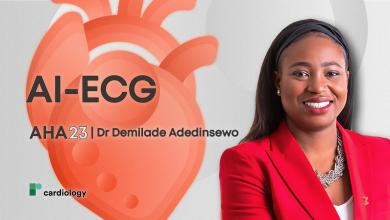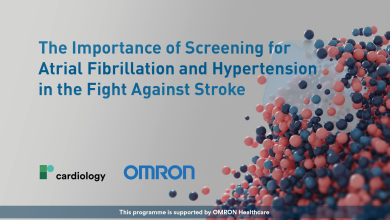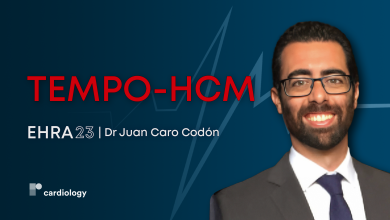Search results
Author(s):
Michael R Massoomi
,
Eileen M Handberg
Added:
3 years ago
Today is an age of rapid digital integration. A decade ago, technological advancement was represented by a bulky desktop computer. With the constant evolution of microprocessors and sophistication of programming, the capacity of the mainframe has been surpassed and miniaturised, so that the pinnacle of technology and innovation is quite literally in the palm of our hands. This opens a world of…
View more
Author(s):
Demilade Adedinsewo
Added:
5 months ago
AHA 23 - We are joined by Dr Demilade Adedinsewo (Mayo Clinic, US) to discuss the findings from a study investigating the effectiveness of an artificial intelligence-enabled ECG (AI-ECG) for cardiomyopathy detection in an obstetric population.In the intervention arm, the digital stethoscope correctly identified 92% of those with ejection fraction <50% and 100% of those with ejection fraction …
View more
Author(s):
Gerhard Hindricks
,
Faizel Osman
,
Keitaro Senoo
,
et al
Added:
5 months ago
This video series page covers content associated with Atrial Fibrillation.AFib is associated with a 5x greater risk of stroke, however with effective treatment, the risk of stroke can be reduced.¹ The lifetime risk for AFib is 1 in 3 individuals² and it often occurs with hypertension. Early detection is key, to allow for prompt and satisfactory disease management to not only control symptoms but…
View more
Author(s):
Ewa Piotrowicz
,
Ryszard Piotrowicz
Added:
3 years ago
Telemedicine (TM) (see Table 1) finds its application most commonly in chronic heart failure (HF).1–3 TM can be useful during exercise training (ET) as a tool to control stability of the clinical status of patients and to supervise training sessions. These goals can be achieved by monitoring clinical symptoms (dyspnoea, fatigue, oedema, chest pain, palpitations, etc.) and monitoring parameters …
View more
Author(s):
Antoni Martínez-Rubio
,
Soledad Ascoeta
,
Fadwa Taibi
,
et al
Added:
3 years ago
In the last months of 2019 and the beginning of 2020, a novel disease appeared, caused by severe acute respiratory syndrome coronavirus 2 (SARS-CoV-2), a very contagious virus, which causes coronavirus disease 2019 (COVID-19). The clinical manifestations of this virus in humans vary widely from asymptomatic to severe, with diverse symptomatology and even death. The substantial transmission from…
View more
Author(s):
Velislav N Batchvarov
Added:
3 years ago
Introduction
The Brugada syndrome (BrS) is a hereditary arrhythmia syndrome manifesting as recurrent syncope or sudden cardiac death (SCD) due to polymorphic ventricular (VT) or fibrillation (VF) in the absence of overt structural heart disease or myocardial ischaemia.1,2 The prevalence of the syndrome is estimated at around 15 per 10,000 in South East Asia including Japan and around 2 per 10,000…
View more
Author(s):
Juan Caro Codón
Added:
1 year ago
EHRA 2023 — Dr Juan Caro Codón (La Paz University Hospital, Madrid, ES) discusses the findings from the TEMPO-HCM study investigating extended ECG monitoring in hypertrophic cardiomyopathy (HCM) patients.
This was a prospective, observational, multicenter trial that included patients with a diagnosis of hypertrophic cardiomyopathy. Investigators compared the rate of clinically relevant…
View more
Author(s):
Klaus Bonaventura
,
Ernst Wellnhofer
,
Eckart Fleck
Added:
3 years ago
Electrocardiograms (ECGs), derived by the transformation of three bipolar quasi-orthogonal leads, have according to EASI lead ECG been introduced for many years for use in emergency situations and for the monitoring of patients during the acute phase of myocardial infarction. Theoretically, a further reduction and simplification of the classic EASI setting of five electrodes may even improve…
View more
Prognostic Value of Stress Myocardial Single-photon-emission Computed Tomography in the Elderly
Author(s):
Santo Dellegrottaglie
,
Pierluigi Costanzo
,
Stefania Paolillo
,
et al
Added:
3 years ago
Article
Author(s):
Jyrki T Kuikka
Added:
3 years ago
Myocardial perfusion imaging (MPI) using combined computed tomography (CT) and single-photon emission CT (SPECT) systems plays an important role in the management of patients with coronary artery disease (CAD).1–4 The method can be used to assess myocardial perfusion and left ventricular function simultaneously. It is an especially valuable tool for assessing short-term risk of CAD, thus…
View more














